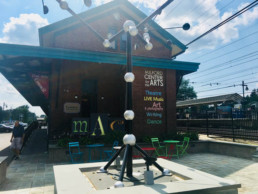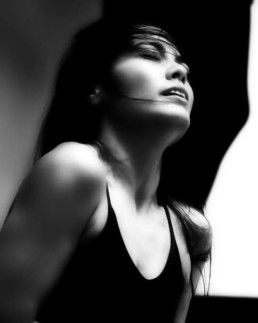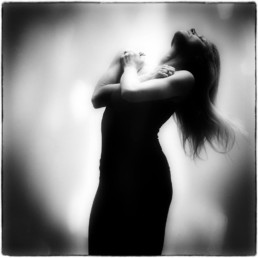RAW: An Evening With Alison Cook Beatty Dance was as the title implies; a two hour concert of repertory excerpts and choreographic experiments by Alison Cook Beatty Dance. Stripped away from costumes and complicated lighting, four female dancers performed in this simple setting, wearing clean, black class-wear.
RAW: An Evening With Alison Cook Beatty Dance offered seven Alison Cook Beatty Dance repertory excerpts. Ms. Alison Cook-Beatty, a Milford native, kindly invited me to observe both tech and performance – it was insightful to see how the company worked through their kinks, gave and received feedback, and transitioned from rehearsal to production. I had the pleasure of watching Ms. Cook-Beatty perform along with Chile native Carolina Rivera; Italy native Vera Paganin; and Brooklyn native Dorrie Silver.
TOUCHED BY FIRE (2001), a solo, opened the program. I viewed Ms. Cook-Beatty dance TOUCHED BY FIRE in 2017 at Ballet Hispanico – I appreciated the reminder that the dance was inspired by a text Ms. Beatty read, titled “Touched With Fire” by Dr. Kay Redfield Jamison. Dr. Jamison’s book explored the artistic temperament. TOUCHED BY FIRE was performed by Ms. Paganin, who brilliantly conveyed the fiery passion suggested by the text and the classic piece of music Cello Suite No. 1 in G Major by Johann Sebastian Bach. Notable also, was that Ms. Paganin did not wear the traditional fiery red costume that TOUCHED BY FIRE calls for. Despite wearing a black leotard, skirt, and a pair of tights, she conveyed the solo’s power as successfully as Ms. Beatty did one year ago when she was dressed in red.
TINTINNABULI (Excerpt) [2012] was a duet danced by Alison Cook-Beatty and Carolina Rivera. This excerpt explored Ms. Cook-Beatty’s interest in creating a piece using a long diagonal from downstage right to upstage left. This interest developed from Doris Humphrey’s statement of, “The diagonals are the most powerful pathways on stage.” Before the performance, dancers visibly taped the stage with brightly colored tape, for audience reference to this idea. A certain aggression existed between Ms. Cook-Beatty and Rivera; as I watched them walk, turn, fall and recover along the taped line, the diagonal gave a sharp angularity to their movements, especially when directed towards one another. For the majority of the duet, only one dancer would move at a time, while the other stood in the downstage right corner and observed. The two women also gestured towards the sky, particularly when executing fast chaîné turns, their arms extended like wings. Though Ms. Cook-Beatty and Ms. Rivera flawlessly executed a series of classical movements, the duet was powerful and confrontational; which goes to show that arabesques, attitude turns, and spirals are not always sweet and dainty. Ms. Rivera’s movement became almost vicious towards Ms. Cook-Beatty at the conclusion of the duet; she slapped her body as she twirled toward Ms. Cook-Beatty, and her long dark, hair swung wildly. I thought this was a successful choice to the performance, as it heightened the frenzied swell of the duet. The duet was danced to Tabula Rasa by Arvo Pärt, which also accentuated the duet’s high and low points of energy.
HOUSTON STREET HOOTENANNY (Excerpt) [2014] came next, which was another Alison Cook Beatty Dance repertory I viewed in 2017. HOUSTON STREET HOOTENANNY was inspired by a peculiar gift that Ms. Cook-Beatty received. She received the gift from a friend when she worked at the Joffrey Ballet School in Greenwich Village: her gift was a large, tattered American flag that was found on train tracks. This shredded flag reminded Ms. Cook-Beatty of the bohemian culture of the 1960’s Greenwich Village neighborhood. HOUSTON STREET HOOTENANNY pays homage to the “resilience, strength, and creativity of the neighborhood and artistic community,” as Ms. Cook-Beatty stated. It also calls the audience to recognize that Americans are “singing the same songs” of war and struggle today that were sung forty years ago.
All four dancers successfully conveyed the 1960’s activism in HOUSTON STREET HOOTENANNY. In the excerpt, the dancers made use of two wooden benches that they danced around and on top of. The dance opens with all dancers seated on a bench, appearing to bend over their legs, grab their wrists, and reach out to something or someone in front of them. Though the dance begins on this somber note with Simon & Garfunkle’s The Sound of Silence, the dance shifts as the music cuts into Disturbed’s rendition of the same song. What struck me about this repertory was the performers’ contrast between mournful and persevering. This was evident between the first and second sections they danced. Intricate gestures warped into expansive movements; their facial expressions reflected their shift in attitudes as well. There was a memorable moment where the dancers acted to rip off purple hearts and medals from their bodies, and throw them back at the White House – “The throwing back of the medals…this did happen,” Ms. Cook-Beatty informed the younger generation of the audience.
GRACE (Excerpt) [2014] appeared fourth on the program, which was a sprightly trio that provided a lighthearted contrast to HOUSTON STREET HOOTENANNY’s intensity. Danced by Ms. Rivera, Ms. Paganin and Ms. Silver, I was swept into their world of springtime, joy and love. The trio was inspired by the music – Un poco Allegretto; No.2 in G Major, Op. 111 by Johannes Brahms – which brought forth visions of cherry blossoms and “all things good.” The trio flowed with classical lines, both in the “V” shapes they made with their arms, and in the diagonals they made with the space. One memorable movement was by Ms. Silver, who executed a smooth decent to the floor (almost reminiscent of the split fall in the Graham Technique), and recovered just as swiftly.
ACCUSED (VARIATION B) (Excerpt) [2012] brought the audience out of Milford and into Sandy Hook Elementary – dedicated to the victims of the 2012 tragedy, Ms. Cook-Beatty was interested in “whether society can be a demonstration of being a victim of domestic events.” This excerpt featured all four women, dancing in a classroom they created with chairs on stage.
In this dance, Ms. Cook-Beatty danced as a tortured soloist, contorting with tension and aggression. The trio, seated on three chairs located downstage right, gripped their chairs with a downward gaze as Ms. Cook-Beatty danced. Ms. Cook-Beatty’s body language was unnerving. She grabbed her face and stared out into the house; she slapped her body and collapsed to the floor; she slowly rolled up to standing and gazed outward with a fiery intensity. The trio, still seated, stomped their feet, their energy too becoming more strained. Soon all four women danced together out of the chairs, yet Ms. Cook-Beatty’s gestures (directing her palm towards the trio, with broken fingers) continued to bring the other three to the floor. Each movement possessed a strong capture of the tragedy. The dancers carried each other around the stage, they knocked the chairs over, and they take the time to angle their torsos towards the sky in order to rise from descents to the floor. ACCUSED (VARIATION B) concluded with the trio slowly walking off stage on the upstage right diagonal. Ms. Cook-Beatty, alone, followed suit. It felt as if a storm had blown through the stage.
MURMURATION (Excerpt) [2016] provided another massive contrast from the previous dance. The audience was swept from Sandy Hook and into a flock of starlings gathering into their flocks – which are called “murmurations.” Ms. Rivera is featured as a soloist in this dance; her attention to detail is evident as she quite literally flies through each bird-like movement with grace and poise. Ms. Rivera dances alongside Ms. Silver, Ms. Cook-Beatty, and Ms. Paganin. All dancers make use of symmetrical arm gestures above their head; on their backs, like wings; and framing their cheek and the midline of their torsos. The dance is sprightly, featuring numerous arabesque hops, sautés and sweet shivers of the dancers as they quiver like birds. This excerpt of MURMURATION was short but very sweet.
Shorter and just as sweet was the final set piece in the program, HUMANITAS (Excerpt) [2017]. This insanely fast, coffee-paced dance featured all four dancers again, and it almost seemed like it was beautiful part choreography and part cardio challenge! The movement never ceased – it was an avalanche of leaps, turns, jumps, falls, pitch turns, and formation changes. Ms. Paganin executed a flawless pitch turn with such speed that caught my eye. The swiftness of the dancers created an image of a whirlpool – and when the one minute of choreography concluded, the dancers collapsed on their backs to give the stage stillness once more.
RAW: An Evening With Alison Cook Beatty Dance concluded with an experiment – Ms. Cook-Beatty demonstrated chance choreographic procedures on her dancers. This gave insight to how she plans to develop her new work, which will premiere in this November 3rd at 8:00 p.m. and 4th at 5:00 p.m. 2018, at The Salvatore Theater at Peridance Capezio Center in New York, NY.
The chance procedures were based on an obstacle course that Ms. Cook-Beatty built using many props from previous dances – such as the three chairs, the benches, etc. On the spot, she instructed her dancers to either leap, roll, crawl under, or turn in specific directions about each prop: “crawl under the bench, leap over the chair, slide to the floor in this direction,” etc. Ms. Rivera, Silver and Paganin all received different instructions. After each dancer had their new choreography, the props were taken away.
The dancers’ brains were sharp indeed. They simultaneously executed their tasks (which they learned in under a minute) to make a coherent new phrase together. The material was about one minute in length, yet it demonstrated to the audience how happy accidents could occur to generate movement. Ms. Cook-Beatty explained that this is a method that she uses with her dancers sometimes, to have base material to build off of.
RAW: An Evening With Alison Cook Beatty Dance gave me much to think about on my Metro North train ride home to New York. I enjoyed the opportunity to see so many excerpts, to get a taste of all the choreographic flavors Ms. Cook-Beatty delves into. From the fiery, the aggressive, the nimble, and the sorrowful, it goes to show that Ms. Cook-Beatty and her dancers are versatile and have strong access to each character they embody.
Author: Kristen Hedberg
Source: http://kristenhedberg.weebly.com/performance-reviews/raw-an-evening-with-alison-cook-beatty-dance




